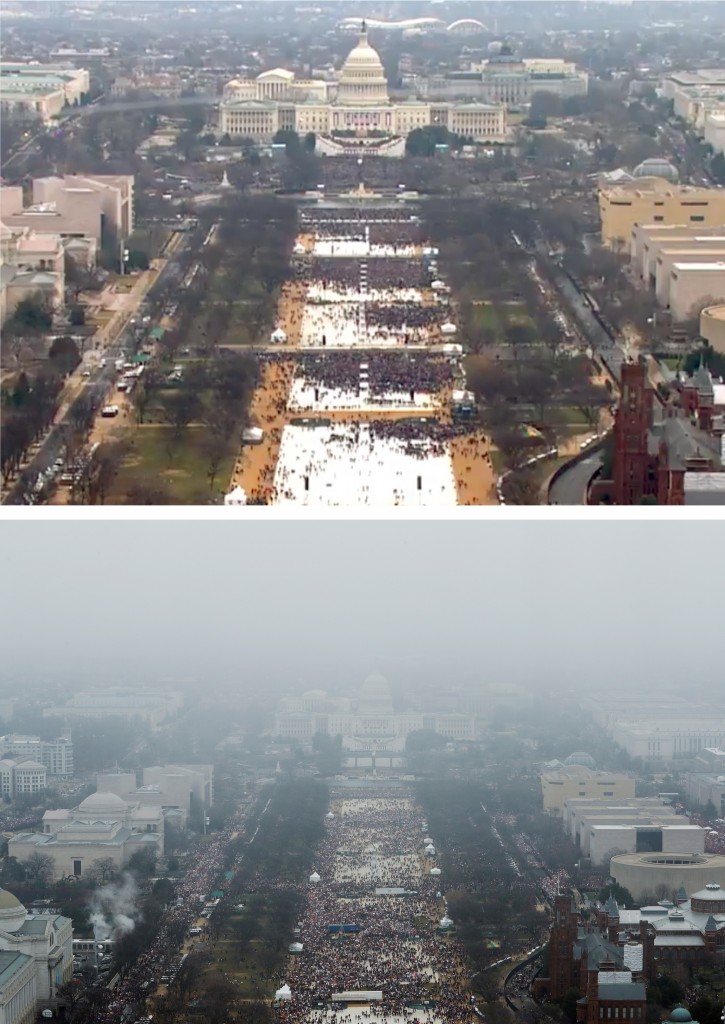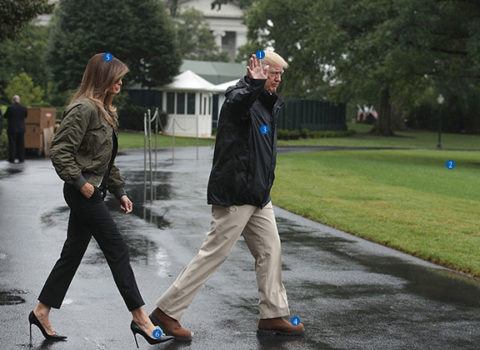
Click to enlarge. Top: Live stream still courtesy 58th Presidential Inaugural Committee. Bottom: Demonstrators take part in the Women’s March to protest Donald Trump’s inauguration as the 45th president of the United States in Washington, D.C., January 21, 2017 © REUTERS/Lucas Jackson
On Saturday, at a dive near Logan Circle in Washington, D.C., there were two bartenders working, both women. “This is the busiest we’ve ever been,” one said, offering a generous pour of Pinot Noir, and looking frantic. The place was brimming with a pink knit Pussyhat-wearing crowd—all elated, all exhausted. Displayed on a large T.V. screen against a back wall was the White House briefing room. Sean Spicer, the press secretary, emerged in a bulky gray suit, his blonde hair combed to one side and his blue eyes bloodshot. “Yesterday, at a time when our nation and the world was watching the peaceful transition of power—and, as the President said, the transition in the balance of power from Washington to the citizens of the United States—some members of the media were engaged in deliberately false reporting.” He suggested that ridership on the D.C. Metro to see Donald Trump be sworn-in as president was higher than it had been for Barack Obama, and that the previous day had seen “the largest audience to ever witness an inauguration, period.” He threw out some numbers, which were wrong. He also said, “No one had numbers,” and went on, “By the way, this applies to any attempts to try to count the number of protesters today in the same fashion.” The cacophony of the bar crescendoed in a unified chorus of “boos.”
The next day, Kellyanne Conway, Trump’s adviser and scarecrow, appeared on NBC’s Meet the Press to defend Spicer’s performance. “Sean Spicer, our press secretary, gave alternative facts,” she explained. By this time, reports were comparing the inauguration turnout—the real number was about 160,000—to that of the Women’s March, which delivered around half a million people to Washington. Counting all participants in some 565 U.S. cities, it is believed to have been the biggest demonstration in American history, drawing over 3.3 million people; marchers outside the country added more. “I don’t think you can prove those numbers one way or another,” Conway went on. “There’s no real way to really quantify crowds, we all know that. You can laugh at me all you want.” Here were the kinds of laughter appropriate for this moment: Chuck Todd, laughing in disbelief at Conway’s answer; the protesters, laughing in amusement at one another’s signs; the good people at Merriam-Webster, laughing at the sudden spike in searches for the word “fact.” The laughter continued into the night, until everybody’s throat began to hurt.
This is a fact: since the Vietnam War, when a crowd of similar size descended on the capitol, the city has rarely been occupied so bigly. (Bigly, another word for Merriam-Webster’s study, was wrangled over by linguists using spectrogram analysis; it was found to have been a mis-hear of Trump saying “big league,” but nevertheless became “the most looked-up word that was never actually used in 2016.”) Nate Silver, the wiz pollster who after this past presidential election seemed more like a bad boyfriend, gave some credence to Conway (“Counting crowds is an inexact science”) but didn’t bail on the concept of math entirely. His site, FiveThirtyEight, collected attendance estimates from local news accounts and weighed them against official reports to calculate reliable figures. Other crowd scientists—suddenly a very controversial field—examined aerial photographs, measuring the average density of 2.5 marchers per square meter. The sky’s view image of the D.C. protest, shown beside that of Trump’s inauguration, depicts the popular vote—which he lost—but not the soundtrack—“Welcome to your first day / We will not go away.” Is that a fact? The temporary joviality of a protest can have an unfortunate effect of supplanting the underlying rage. There was revelry, chanting, clinking. And then the masses went home.
The messages at the rally were varied. Uterus signs offended transgender women. Black marchers grumbled at the fact—a real one—that 53 percent of white female voters chose Trump on Election Day. Hillary Clinton’s supporters darted eyes at Bernie Bros. Behind the stage, a woman and a man holding a “Trump-Pence” sign were swarmed by a group of marchers, who seized an opportunity to face the opposition; a passerby called out, “Don’t engage!” America Ferrera, the actress and activist, seemed to notice the awkwardness. In her speech, she said, “If we—the millions of Americans who believe in the decency, in the greater good, that justice is for all—if we fall into the trap of separating ourselves by our causes and labels, it will weaken our fight and we will lose.”
At the bar, among friends, people forgot to worry for a little while. The line to the ladies’ room was orderly. Someone lost her ring, and a search was swiftly conducted by a coalition of strangers. A customer told the woman pouring her drink, “You’ve done more for the march today than all of us in this room combined.” The first day of the “American carnage” president hadn’t felt so bad. (“Trump is the cure here,” Jeff Merkley, a Senator from Oregon told the New York Times. “He brings everybody together.”) In the din, one could not hear Trump down the street, signing executive orders in the interest of dismantling the Affordable Care Act, withdrawing from the Trans Pacific Partnership, and blocking funding for NGO’s that provide or “promote” abortions. Nobody uttered the name “Kushner,” even as he was approved to a White House job by the Justice Department. For a night, the 3.3 million marchers took some time to rest, and to laugh—all of them, all they wanted.
Help support our ongoing coverage of Donald Trump by subscribing to Harper’s Magazine today!





